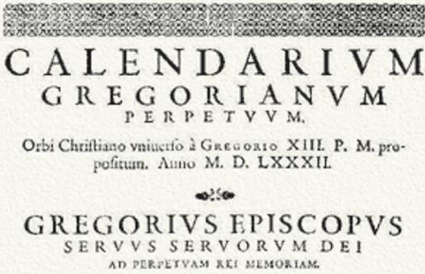For some unknown reason, I always believed that the Gregorian calendar was something I'd never seen in my life. So you can imagine how surprised I was to find out that this is not only the civil calendar, but also has been the unofficial global standard for decades and is recognized by several international institutions.
It is also called the Western calendar and the Christian calendar and it was a refinement made in 1582 to the Julian calendar amounting to a 0.002% correction in the length of the year. The motivation for the reform was to bring the date for the celebration of Easter to the time of the year in which the First Council of Nicaea had agreed upon in 325. Because the celebration of Easter was tied to the spring equinox, the Roman Catholic Church considered this steady drift in the date of Easter undesirable. The reform was adopted initially by the Catholic countries of Europe. Protestants and Eastern Orthodox countries continued to use the traditional Julian calendar and adopted the Gregorian reform after a time, for the sake of convenience in international trade. The last European country to adopt the reform was Greece, in 1923.
The Gregorian reform contained two parts: a reform of the Julian calendar as used prior to Pope Gregory XIII's time and a reform of the lunar cycle used by the Church, with the Julian calendar, to calculate the date of Easter. The reform was a modification of a proposal made by Aloysius Lilius. His proposal included reducing the number of leap years in four centuries from 100 to 97, by making 3 out of 4 centurial years common instead of leap years. Lilius also produced an original and practical scheme for adjusting the epacts of the moon when calculating the annual date of Easter, solving a long-standing obstacle to calendar reform.
In addition to the change in the mean length of the calendar year from 365.25 days (365 days 6 hours) to 365.2425 days (365 days 5 hours 49 minutes 12 seconds), a reduction of 10 minutes 48 seconds per year, the Gregorian calendar reform also dealt with the accumulated difference between these lengths. Between AD 325 (when the First Council of Nicaea was held, and the vernal equinox occurred approximately 21 March), and the time of Pope Gregory's bull in 1582, the vernal equinox had moved backward in the calendar, so that in 1582 it occurred about 11 March, 10 days earlier than 21 March. The Gregorian calendar therefore began by skipping 10 calendar days, to restore 21 March as the date of the vernal equinox.
Though not part of the Gregorian calendar itself, the reformed calendar continued the previous year-numbering system (Anno Domini), which counts years from the traditional date of the Nativity, originally calculated in the 6th century and in use in much of Europe by the High Middle Ages. This year-numbering system, now also called the Common Era, is the predominant international standard today.
It is also called the Western calendar and the Christian calendar and it was a refinement made in 1582 to the Julian calendar amounting to a 0.002% correction in the length of the year. The motivation for the reform was to bring the date for the celebration of Easter to the time of the year in which the First Council of Nicaea had agreed upon in 325. Because the celebration of Easter was tied to the spring equinox, the Roman Catholic Church considered this steady drift in the date of Easter undesirable. The reform was adopted initially by the Catholic countries of Europe. Protestants and Eastern Orthodox countries continued to use the traditional Julian calendar and adopted the Gregorian reform after a time, for the sake of convenience in international trade. The last European country to adopt the reform was Greece, in 1923.
The Gregorian reform contained two parts: a reform of the Julian calendar as used prior to Pope Gregory XIII's time and a reform of the lunar cycle used by the Church, with the Julian calendar, to calculate the date of Easter. The reform was a modification of a proposal made by Aloysius Lilius. His proposal included reducing the number of leap years in four centuries from 100 to 97, by making 3 out of 4 centurial years common instead of leap years. Lilius also produced an original and practical scheme for adjusting the epacts of the moon when calculating the annual date of Easter, solving a long-standing obstacle to calendar reform.
In addition to the change in the mean length of the calendar year from 365.25 days (365 days 6 hours) to 365.2425 days (365 days 5 hours 49 minutes 12 seconds), a reduction of 10 minutes 48 seconds per year, the Gregorian calendar reform also dealt with the accumulated difference between these lengths. Between AD 325 (when the First Council of Nicaea was held, and the vernal equinox occurred approximately 21 March), and the time of Pope Gregory's bull in 1582, the vernal equinox had moved backward in the calendar, so that in 1582 it occurred about 11 March, 10 days earlier than 21 March. The Gregorian calendar therefore began by skipping 10 calendar days, to restore 21 March as the date of the vernal equinox.
Though not part of the Gregorian calendar itself, the reformed calendar continued the previous year-numbering system (Anno Domini), which counts years from the traditional date of the Nativity, originally calculated in the 6th century and in use in much of Europe by the High Middle Ages. This year-numbering system, now also called the Common Era, is the predominant international standard today.
~Ally

 RSS Feed
RSS Feed